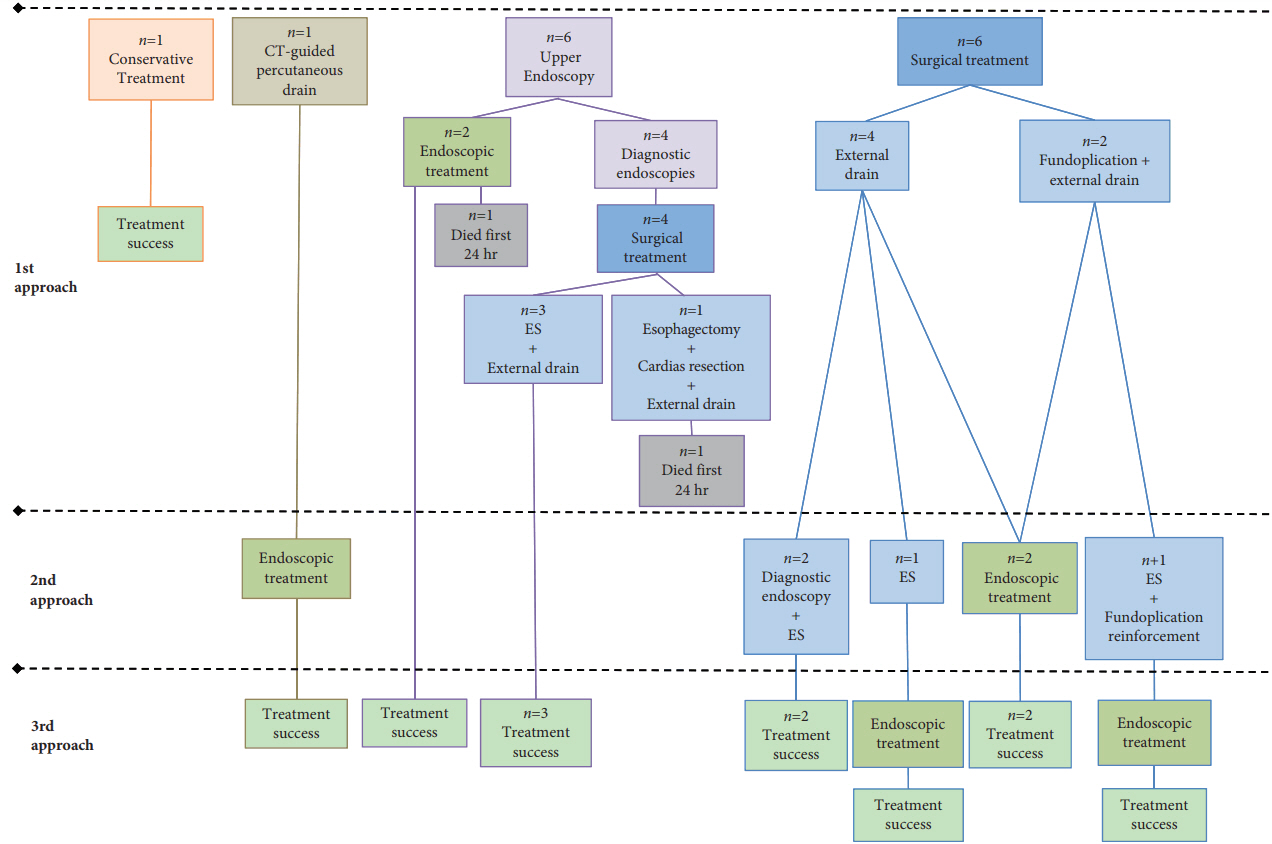Clin Endosc.
2018 Mar;51(2):186-191. 10.5946/ce.2017.043.
Role of Endoscopy in the Management of Boerhaave Syndrome
- Affiliations
-
- 1Department of Gastroenterology, North Hospital, University of Mediterranean, Chemin des Bourrely, Marseille, France. juanchoit@hotmail.com
- 2Department of Thoracic Surgical, North Hospital, University of Mediterranean, Chemin des Bourrely, Marseille, France.
- KMID: 2410987
- DOI: http://doi.org/10.5946/ce.2017.043
Abstract
- Boerhaave syndrome (BS) is a spontaneous esophageal perforation which carries high mortality. Surgical treatment is well established, but the development of interventional endoscopy has proposed new therapies. We expose our experience in a Gastrointestinal and Endoscopy Unit. With a retrospective, observational, open-label, single center, consecutive case series. All patients diagnosed with BS who were managed in our center were included. Treated conservatively, endoscopically or surgically, according to their clinical condition and lesion presentation. Fourteen patients were included. Ten were treated with primary surgery. One conservatively. In total, 7/14 patients required an endoscopic treatment. All required metallic stents deployment, 3 cases over-the-scope-clips concomitantly and one case a novel technique an internal drain. 6/7 cases endoscopically treated achieved complete esophageal healing. In conclusion, endoscopy is an useful tool at all stages BS management: difficult diagnosis, primary treatment in selected patients and as salvage when surgery fails. With mortality rates and outcomes comparables to surgery.
Keyword
MeSH Terms
Figure
Reference
-
1. Anwuzia-Iwegbu C, Al Omran Y, Heaford A. Against all odds. Conservative management of Boerhaave’s syndrome. BMJ Case Rep. 2014; 2014.
Article2. Derbes VJ, Mitchell RE Jr. Hermann Boerhaave’s atrocis, nec descripti prius, morbi historia, the first translation of the classic case report of rupture of the esophagus, with annotations. Bull Med Libr Assoc. 1955; 43:217–240.3. de Schipper JP, Pull ter Gunne AF, Oostvogel HJ, van Laarhoven CJ. Spontaneous rupture of the oesophagus: Boerhaave’s syndrome in 2008. Literature review and treatment algorithm. Dig Surg. 2009; 26:1–6.4. Darrien JH, Kasem H. Minimally invasive endoscopic therapy for the management of Boerhaave’s syndrome. Ann R Coll Surg Engl. 2013; 95:552–556.
Article5. Griffin SM, Lamb PJ, Shenfine J, Richardson DL, Karat D, Hayes N. Spontaneous rupture of the oesophagus. Br J Surg. 2008; 95:1115–1120.
Article6. Gonzalez JM, Garces Duran R, Vanbiervliet G, et al. Double-type metallic stents efficacy for the management of post-operative fistulas, leakages, and perforations of the upper gastrointestinal tract. Surg Endosc. 2015; 29:2013–2018.
Article7. Fischer A, Thomusch O, Benz S, von Dobschuetz E, Baier P, Hopt UT. Nonoperative treatment of 15 benign esophageal perforations with self-expandable covered metal stents. Ann Thorac Surg. 2006; 81:467–472.
Article8. van Heel NC, Haringsma J, Spaander MC, Bruno MJ, Kuipers EJ. Shortterm esophageal stenting in the management of benign perforations. Am J Gastroenterol. 2010; 105:1515–1520.
Article9. Musala C, Eisendrath P, Brasseur A, et al. Successful treatment of Boerhaave syndrome with an over-the-scope clip. Endoscopy. 2015; 47 Suppl 1 UCTN:E24–E25.
Article10. Dickinson KJ, Buttar N, Wong Kee Song LM, et al. Utility of endoscopic therapy in the management of Boerhaave syndrome. Endosc Int Open. 2016; 4:E1146–E1150.
Article11. González-Haba M, Ferguson MK, Gelrud A. Spontaneous esophageal perforation (Boerhaave syndrome) successfully treated with an over-the- scope clip and fully covered metal stent. Gastrointest Endosc. 2016; 83:650.
- Full Text Links
- Actions
-
Cited
- CITED
-
- Close
- Share
- Similar articles
-
- Successful Treatment Using Endoluminal Vacuum Therapy after Failure of Primary Closure in Boerhaave Syndrome
- A Case of Nonsurgical Treatment in Boerhaave's Syndorme during Diagnostic Endoscopy
- A Case of Esophagopleural Fistula Treated by Endoscopic Injection of Histoacryl in Boerhaave's Syndrome
- Two Cases of Boerhaave's Syndrome Treated by Endoscopic Hemoclipping
- Successful Management of Delayed Esophageal Rupture with T-Tube Drainage Using Video-Assisted Thoracoscopic Surgery


